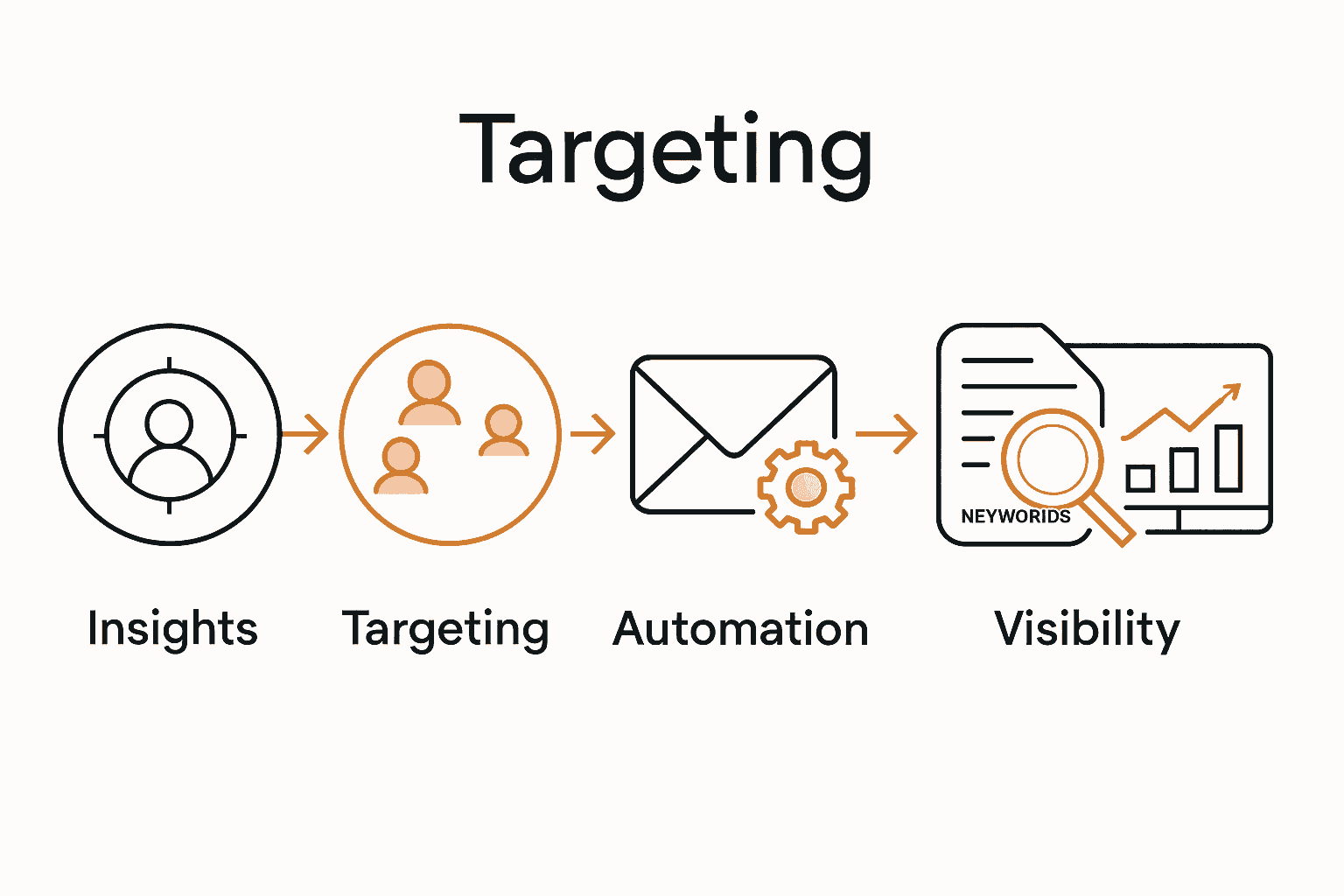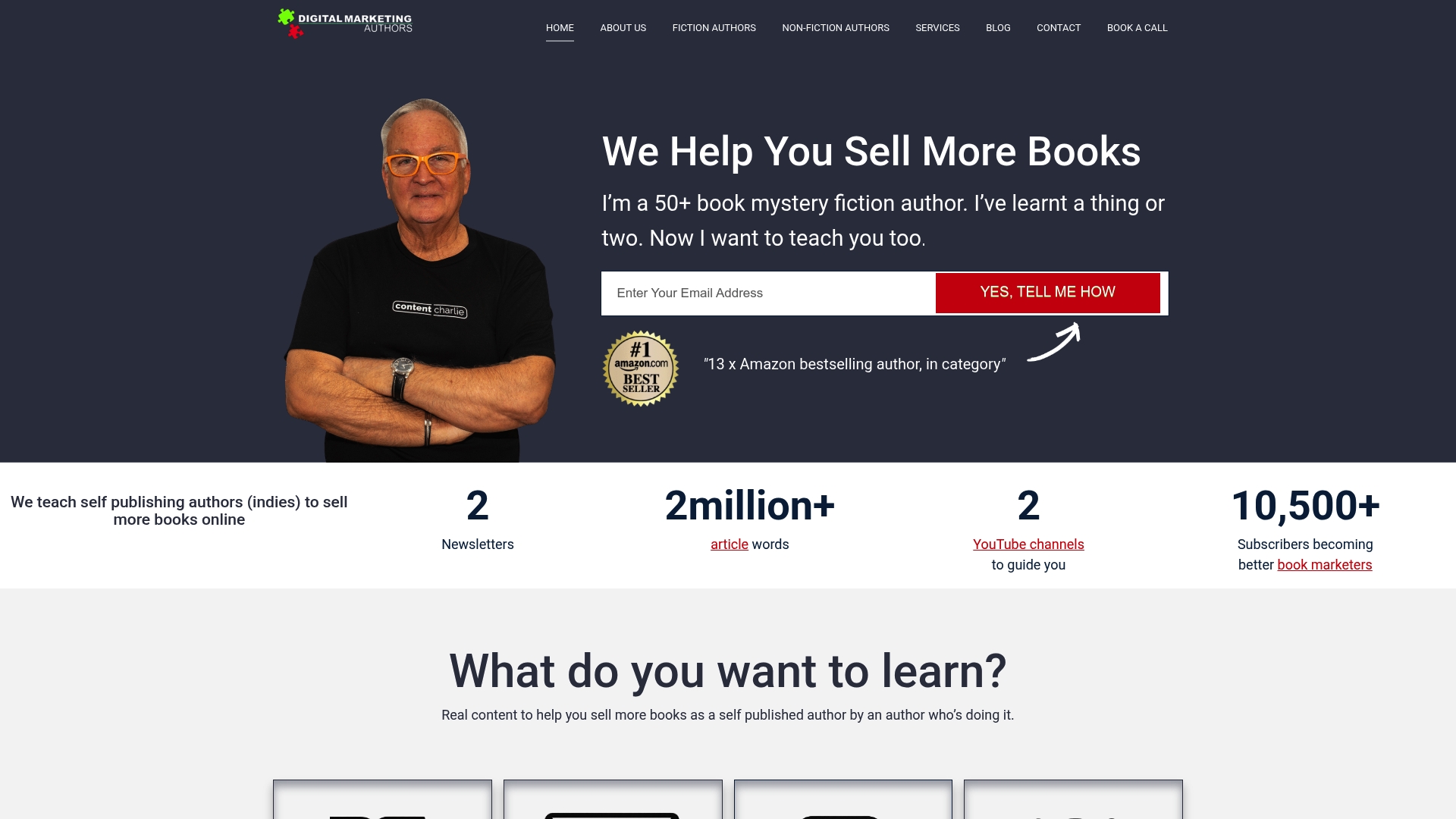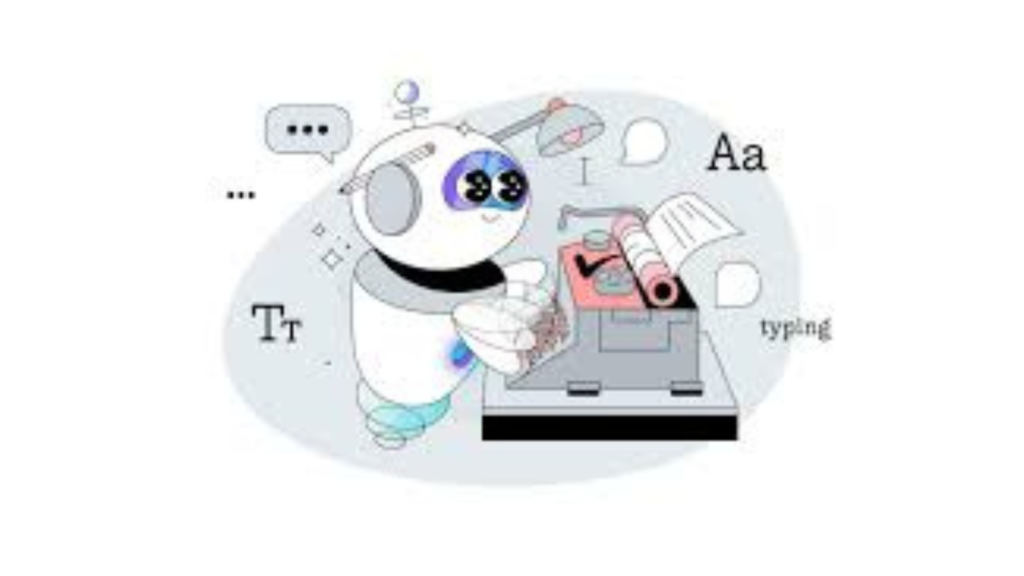- You are here:
- Home »
- AI Writing
Category Archives for AI Writing

AI Strategies for Book Marketing: Boost Sales with Proven Steps
Over 80 percent of authors who use AI in their marketing see a significant rise in reader engagement. Connecting your book with its perfect audience can feel overwhelming, yet targeted strategies and smart tools make the difference between missed opportunities and true fan connection. Discover how authors are using data and AI techniques to craft authentic marketing that increases discoverability, builds loyalty, and drives sales.
Quick Summary
| Key Point | Explanation |
|---|---|
| 1. Understand Your Author Brand | Analyze your author brand and audience data to create targeted marketing strategies. |
| 2. Leverage AI for Targeting | Use AI tools to segment your audience and provide personalized marketing messages. |
| 3. Create Automated Email Sequences | Develop automated, engaging email sequences tailored to reader interactions for better conversions. |
| 4. Optimize Book Listings with AI | Utilize AI writing tools to enhance your book descriptions for improved visibility in searches. |
| 5. Monitor and Adjust Your Campaigns | Regularly track performance metrics and refine your strategies based on reader engagement and feedback. |
Table of Contents
- Step 1: Assess Your Author Brand And Audience Data
- Step 2: Integrate AI Tools For Reader Targeting
- Step 3: Automate Email Sequences Using AI Insights
- Step 4: Optimize Book Listings With AI-Powered Content
- Step 5: Monitor Results And Refine AI Marketing Campaigns
Step 1: Assess Your Author Brand and Audience Data
Successful book marketing begins with understanding your unique author brand and knowing exactly who your readers are. This step helps you create targeted strategies that connect authentically with your audience.
Start by conducting a comprehensive audience analysis using AI-powered tools. According to a 2024 research study from the author visibility online archives, personalization at scale allows authors to tailor their narrative precisely to audience context and preferences.
Gather data through multiple channels. Examine your existing reader demographics from social media insights, email subscriber information, and book review platforms. Look for patterns in age groups, reading preferences, geographic locations, and engagement levels. The SOMONITOR framework suggests using explainable AI to analyze audience personas and refine your brand strategy based on actual campaign data.
Create a detailed reader persona that goes beyond basic demographics. What are their reading habits? What emotional needs do your books fulfill? What challenges might prevent them from discovering your work?
Pro Tip: AI analysis tools can help uncover nuanced insights about your audience that traditional market research might miss.
Once you have a clear picture of your audience, you can start crafting marketing messages that resonate deeply and authentically. Your next step will be developing a targeted marketing approach based on these insights.
Step 2: Integrate AI Tools for Reader Targeting
Now that you understand your audience, its time to leverage AI tools to precisely target and engage your potential readers. This step will help you transform audience insights into strategic marketing actions.
Start by exploring AI powered tools designed for reader targeting. According to a 2024 academic study on marketing personalization, AI can leverage consumer behavior patterns to deliver highly targeted recommendations. AI tools for writers can help you analyze reader preferences with unprecedented accuracy.
Implement AI driven segmentation strategies. Adobe research indicates that brands can now tailor messages based on user activity and profile characteristics. For authors, this means creating laser focused marketing campaigns that speak directly to specific reader segments. Consider using AI platforms that can track reader interactions across multiple channels like social media, book review sites, and email platforms.

Utilize predictive analytics to understand reader interests. AI algorithms can help you anticipate reading preferences by analyzing patterns in genre selection, reading speed, and engagement metrics. This allows you to craft marketing messages that resonate on a deeply personal level.
Pro Tip: Always balance AI insights with your authentic author voice to maintain genuine reader connections.
By integrating these AI targeting strategies, you transform generic marketing into a precision instrument for reader engagement. Your next step involves developing personalized content that speaks directly to these identified reader segments.
Step 3: Automate Email Sequences Using AI Insights
Transform your reader communication by creating smart, automated email sequences that engage and convert potential readers. This step will help you build a powerful marketing system that works continuously without constant manual intervention.
Begin by mapping out a strategic email sequence using insights from artificial intelligence marketing for authors. According to FriesenPress, a successful email automation flow typically includes multiple stages: a welcome email with a free chapter, a delayed follow-up prompting purchase, and subsequent messages that encourage series continuation.
Leverage AI tools to personalize each email touchpoint based on reader interactions. This means crafting emails that dynamically adjust content depending on how readers have previously engaged with your books or marketing materials. An author marketing resource suggests creating automated post-purchase sequences that include follow-ups and review prompts triggered by specific purchase events.
Design your email sequence to feel conversational and authentic. Use AI to help analyze language patterns that resonate with your specific reader segments. This allows you to create messages that sound personal and engaging rather than generic and automated.
Pro Tip: Always include an easy unsubscribe option and respect reader preferences to maintain trust.
By implementing these AI-powered email automation strategies, you create a sophisticated marketing system that nurtures reader relationships effortlessly.
Your next step involves tracking and refining these email sequences based on reader engagement metrics.
Step 4: Optimize Book Listings with AI-Powered Content
Make your book stand out in a crowded marketplace by leveraging AI technologies to create compelling and searchable book listings. This step will transform your book description from generic text to a strategic marketing tool that attracts and converts potential readers.
Utilize AI writing tools to craft metadata and descriptions that maximize discoverability. AI-powered book promotion strategies can help you analyze keyword trends and optimize your book listing for search algorithms used by platforms like Amazon.
Generate multiple description variations using AI to test which resonates most with your target audience. AI can help you analyze language patterns that trigger reader interest by examining successful book descriptions in your genre. This means creating metadata that not only describes your book but also speaks directly to your ideal reader.
Implement AI-driven keyword optimization to improve your book visibility. Focus on long-tail keywords that precisely match potential reader search intentions. Consider using AI tools that can suggest semantically related terms that expand your book’s discoverability without feeling forced or unnatural.
Pro Tip: Always review and personalize AI generated content to maintain your unique author voice.
By strategically applying these AI optimization techniques, you create book listings that are both algorithmically intelligent and authentically compelling. Your next step involves tracking listing performance and continuously refining your approach.
Step 5: Monitor Results and Refine AI Marketing Campaigns
Transform your book marketing approach from guesswork to precision by implementing systematic tracking and continuous optimization of your AI powered campaigns. This step will help you understand what truly drives reader engagement and sales.
Leverage advanced campaign tracking tools to monitor your marketing performance in real time. According to the SOMONITOR explainable AI framework, continuous analytics enable authors to interpret campaign data and refine messaging strategies dynamically.
Set up comprehensive tracking dashboards that capture key performance indicators such as email open rates, click through rates, book listing conversions, and reader engagement metrics. AI platforms like AI Amazon Listings offer performance tracking features that can automatically recommend optimization strategies based on your current campaign data.
Implement a systematic approach to campaign refinement. This means regularly analyzing your metrics not just for surface level numbers but for deeper insights into reader behavior. Look for patterns in how different audience segments respond to your marketing messages and adjust your strategies accordingly.
Pro Tip: Treat your marketing campaigns like scientific experiments continuous testing and incremental improvements will yield the best results.
By adopting this data driven approach to marketing, you transform your book promotion from a static process to a dynamic intelligent system. Your next step involves integrating these insights into an evolving marketing strategy that grows more effective with each campaign.
Here’s a comparison of key AI strategies for each step of author book marketing:
| Step | Main AI Strategy | Primary Benefits |
|---|---|---|
| Assess Brand & Audience | Audience analysis tools | Deep reader insights Persona refinement |
| Reader Targeting | Segmentation & predictive analytics | Targeted messaging Higher engagement |
| Automate Emails | AI-driven sequences | Personalized emails Improved conversions |
| Optimize Listings | AI content & keyword tools | Better visibility Higher discoverability |
| Monitor & Refine | Campaign tracking & analytics | Real-time adjustments Continuous improvement |
Ready to Turn Data Into Book Sales?

Tired of wondering if your book promo is reaching the right readers? The article above reveals a problem many authors face: generic marketing and missed connections leave promising books languishing in obscurity. Discover how AI-driven audience analysis, tailored messaging, and automated campaigns can finally break the cycle so your work finds the loyal fans it deserves. If you crave a system that transforms insights into real reader engagement, you are in the right place.

At Digital Marketing Authors you can access proven frameworks for AI-powered book marketing. Founded by an Amazon bestselling author, our platform teaches you to personalize every campaign, automate your email outreach, and amplify your author brand. Master the same strategies featured in our AI tools for writers resources to boost your visibility and finally scale your readership.
Visit Digital Marketing Authors today and unlock smart systems built for indie authors ready to grow now. Take action and watch your book sales thrive with targeted AI solutions.
Frequently Asked Questions
How can I analyze my audience effectively for book marketing?
To analyze your audience effectively, use AI-powered tools to collect data from various channels such as social media and email subscribers. Track demographics, reading preferences, and engagement levels to create a detailed reader persona that informs your marketing strategies.
What are the benefits of using AI tools for reader targeting?
Using AI tools for reader targeting allows you to deliver personalized marketing messages based on consumer behavior patterns. Implement AI-driven segmentation to craft campaigns that speak directly to specific reader segments, potentially increasing engagement by over 30%.
How can I automate my email marketing sequences?
You can automate your email marketing sequences by mapping out a strategic flow that includes welcome messages, follow-ups, and post-purchase communications. Use AI to personalize content for each email based on reader interactions, which can significantly improve conversion rates within the first few weeks after implementation.
What should I include in my book listing descriptions to optimize visibility?
To optimize your book listing descriptions, focus on crafting compelling metadata using AI tools. Incorporate relevant long-tail keywords that match potential reader search intentions, which can enhance discoverability and increase your book’s visibility in search results.
How can I monitor and refine my AI marketing campaigns?
You can monitor and refine your AI marketing campaigns by setting up tracking dashboards that assess key performance indicators such as email open rates and engagement metrics. Analyze these metrics regularly to make data-driven adjustments, enhancing campaign effectiveness by around 20% over time.
What steps should I take for ongoing optimization of my marketing strategies?
For ongoing optimization, implement a systematic approach to regularly analyze campaign data for insights on audience response. Treat your marketing campaigns as continuous experiments, allowing you to test and adjust strategies for gradual improvement.
Recommended

copywriting AI work
Can You Copyright AI Generated Work?
The U.S. Copyright Office has finally clarified its stance on AI-generated content and whether it qualifies for copyright protection. This long-awaited decision sheds light on a critical issue for authors, artists, and businesses using AI tools to create content.
So, can you copyright AI-generated work? Yes, but with conditions. Let’s break down what this ruling means and how you can protect your AI-assisted creations.
The Big Question: Can AI Work Be Copyrighted?
For years, one of the most debated topics in intellectual property law has been whether AI-generated content can be copyrighted.
The U.S. Copyright Office’s latest report confirms that some AI-generated content can be protected—if a human has made substantial creative contributions. However, AI-generated work alone, without human intervention, does not qualify for copyright protection.
Key Takeaway:
👉 AI is a tool, not an author.
👉 Human creativity must be central for copyright eligibility.
👉 If you modify, arrange, or build upon AI-generated content, you can copyright it.
Now, let’s explore the specifics of what qualifies for copyright and what doesn’t.
What AI-Generated Work Qualifies for Copyright?
The Copyright Office provided several scenarios in which AI-generated content may be eligible for copyright protection:
1. When AI is Used as a Creative Assistant
If AI helps refine, edit, or enhance human-created content, that content remains copyrightable.
✔ Example: An author writes a rough draft and uses AI to refine the language and structure.
2. When AI-Generated Work is Significantly Modified by a Human
If a human extensively edits or rearranges AI-generated material, it can be copyrighted.
✔ Example: A graphic designer uses AI-generated art but heavily modifies the images using Photoshop before publishing them.
3. When AI is Used to Generate Drafts, But a Human Finalizes the Work
If AI creates a draft that a human then polishes, revises, and expands upon, it is eligible for copyright.
✔ Example: A writer uses AI to generate a basic outline or plot ideas but then writes the final story manually.
4. When AI Content is Combined with Human-Created Work
If an AI-generated element is incorporated into a larger, human-created project, the overall work can qualify for copyright.
✔ Example: A filmmaker stitches together AI-generated video clips with original footage to create a final product.
What AI-Generated Work Does NOT Qualify for Copyright?
There are strict limitations on what AI-generated content can be copyrighted. The Copyright Office ruled that:
🚫 AI-generated work with no human modification cannot be copyrighted.
🚫 Simple prompts alone do not establish authorship.
🚫 If AI creates the entire work without human intervention, it remains in the public domain.
This means that if you simply input a prompt into an AI tool (like ChatGPT or MidJourney) and publish the raw output without making any creative changes, it does not qualify for copyright.
What About AI and Copyrighted Training Data?
One of the biggest ongoing legal battles in AI is whether training AI models on copyrighted content is considered infringement. The Copyright Office has not ruled on this issue yet, but it has announced that a third section of its report will address:
🔍 Liability of AI companies for using copyrighted materials
🔍 Potential licensing agreements for AI training data
🔍 How copyright law applies to AI models trained on existing works
With multiple lawsuits already in motion against companies like OpenAI and Stability AI, the future of AI training and copyright remains uncertain.
AI Copyright for Different Mediums
📚 AI-Generated Books & Articles
If a human edits, rewrites, or modifies AI-generated text, the book or article can be copyrighted.
✔ Tip: Always revise AI-generated writing to ensure originality and eligibility for copyright.
🖼️ AI-Generated Artwork
If AI creates an image without human modification, it is not eligible for copyright. However, if an artist edits or arranges AI images into a larger composition, it may be copyrighted.
✔ Example: A comic book using AI-generated backgrounds but with original character illustrations could be copyrighted.
🎬 AI-Generated Videos
Simply generating a video from an AI tool like Runway or Pika does not qualify for copyright. However, if a human edits, modifies, or combines AI-generated clips into a unique project, it can be copyrighted.
✔ Example: A filmmaker curates and edits multiple AI-generated clips to create a cohesive short film.
Final Verdict: AI as a Tool, Not a Creator
The Copyright Office has made it clear: human creativity must be central to a work for it to receive copyright protection. AI can assist, enhance, and generate ideas, but it cannot replace human authorship.
What This Means for You:
✅ If you use AI as a tool and edit the content, you can copyright your work.
❌ If you publish raw AI-generated material without modification, it remains uncopyrightable.
The legal landscape for AI and copyright is still evolving, and future rulings could change how AI-assisted work is protected. But for now, AI is a creative assistant, not a replacement for human authors.

Writing with AI for Beginners: A Step-by-Step Guide
Writing with AI isn’t as simple as pressing a button and watching a book magically appear. Many beginners give up quickly when their first attempts produce low-quality, generic, or unusable content. However, by using the right tools, models, and techniques, AI can transform your writing process and even enhance creativity.
In this guide, we’ll cover:
✔️ The best AI writing tools
✔️ How to get better output from AI
✔️ Key techniques to improve AI-generated content
Whether you’re a fiction author, blogger, or non-fiction writer, this guide will help you unlock AI’s full potential in your writing.
Understanding AI Writing: Large Language Models vs. Writing Tools
AI writing is powered by Large Language Models (LLMs)—advanced AI systems trained on vast amounts of data. However, AI tools act as the interface that makes using these models easier.
What Are Large Language Models (LLMs)?
LLMs are the brains behind AI writing. The most popular ones include:
- GPT-4 (OpenAI) – Used in ChatGPT and many AI writing tools.
- Claude (Anthropic) – Known for its creative and structured writing.
- Gemini (Google) – A powerful AI with advanced reasoning.
- Llama (Meta) – Open-source AI for customized models.
- Mistral – Popular for specific writing tasks and content generation.
AI Writing Tools That Use LLMs
AI tools wrap LLMs into user-friendly platforms, providing additional features such as content structuring, brainstorming, and formatting.
Some of the most effective AI writing tools for beginners include:
✔️ ChatGPT (OpenAI) – A flexible AI chatbot for writing, brainstorming, and editing.
✔️ Claude (Anthropic) – Great for fiction and structured content.
✔️ Sudowrite – Tailored for novelists, with AI-assisted storytelling features.
✔️ NovelCrafter – Built specifically for long-form fiction writing.
✔️ RiteBot AI – A tool for generating articles, book outlines, and AI-assisted brainstorming.
How to Use AI Effectively for Writing
Many beginners struggle with AI because they expect perfect content from the start. The key is to guide the AI properly using the following strategies.
1. The F.I.T.S Framework for Better AI Output
To get high-quality writing, follow the F.I.T.S. method when prompting AI:
🔹 F – Framework
Give the AI a clear structure to follow. Instead of saying “Write a novel outline,” say:
📝 “Create a novel outline using the Hero’s Journey structure.”
🔹 I – Identity
Assign the AI a role to improve accuracy. For example:
📝 “You are a bestselling mystery author. Write a gripping first chapter.”
🔹 T – Task
Be specific about what you want the AI to do. Instead of “Write about space travel,” say:
📝 “Write a detailed introduction about the effects of space travel on human psychology.”
🔹 S – Style
Give style instructions to match your voice. Instead of “Write a story,” say:
📝 “Write a suspenseful crime scene in the style of Agatha Christie.”
2. The Fractal Technique: Writing in Steps
Instead of generating full articles or books in one go, break the writing process into smaller steps:
1️⃣ Brainstorm Ideas – Ask AI to suggest unique book or article ideas.
2️⃣ Outline the Structure – Generate a chapter-by-chapter breakdown.
3️⃣ Expand Key Points – Flesh out sections one by one.
4️⃣ Draft the Content – Let AI generate a first draft based on your outline.
5️⃣ Edit & Validate – Manually refine the AI’s output for accuracy and style.
By working step-by-step, you keep the writing process structured and manageable.
3. Chain-of-Thought Prompting: AI That Thinks Before Writing
Instead of asking AI to “Write an article,” guide it through a thinking process first:
✔️ Step 1: Ask AI to plan the content
📝 “Create a detailed outline for an article about AI writing for beginners.”
✔️ Step 2: Review & refine the outline
📝 “Now expand on Point 1 with examples and clear explanations.”
✔️ Step 3: Let AI write based on the outline
📝 “Using the outline, generate a detailed article in a conversational tone.”
This technique helps AI produce higher-quality and more structured content.
Best AI Settings for Writing: Tweaking the Output
When using AI directly through an API (such as OpenAI’s Playground or OpenRouter), you can control specific parameters for better results:
✔️ Temperature:
- Lower (0.7 or below) → More factual & predictable writing.
- Higher (1.2 or above) → More creative & unpredictable writing.
✔️ Max Tokens:
- Affects how much AI can generate in one response.
- Increase if AI cuts off mid-sentence.
✔️ Top P & Frequency Penalty:
- Adjusts variety & repetition in AI’s word choices.
For long-form writing, keeping temperature at 1.0-1.2 gives a balance of creativity and coherence.
AI for Editing & Refining Content
Even the best AI-generated drafts need editing. Here’s how AI can also help polish writing:
✔️ Grammar & Clarity:
Tools like ProWritingAid or Grammarly refine AI-generated text.
✔️ Style Adjustments:
Ask AI to rewrite content in a different tone or complexity level.
📝 “Make this paragraph more engaging and conversational.”
✔️ Fact-Checking & Validation:
AI can assist with research, but always verify sources manually.
Conclusion: AI Writing is a Tool, Not a Replacement
AI won’t replace human creativity, but it can enhance productivity and idea generation. The key to success is understanding how to guide AI properly.
✅ Use the right AI tools for your needs.
✅ Apply structured prompts like the F.I.T.S. method.
✅ Break writing into steps using the Fractal Technique.
✅ Refine AI-generated content with editing tools and manual input.
By combining AI efficiency with human creativity, you can write faster, smarter, and better!
